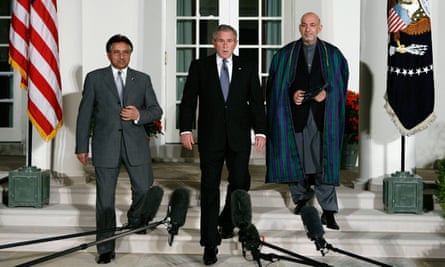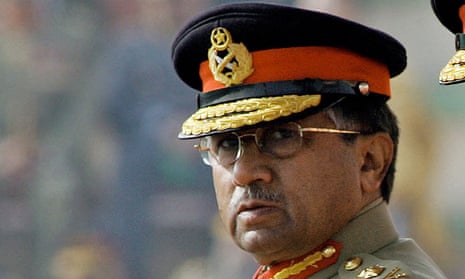Of all Pakistan’s assorted mixture of leaders since independence, none so divided opinion at home and abroad as General Pervez Musharraf, who seized power in a bloodless coup in October 1999.
Vilified and praised in equal measure, Musharraf, who has died aged 79, left a legacy that is certain to compound the uncertainties that have dogged Pakistan since its creation in 1947. For many of his critics, the general was typical of the country’s long line of ruthless military dictators, who appeased Islamic militants in an effort to clip the ambitions of secular parties opposed to military rule.
For others he represented a man of vision, who offered Pakistan the best hope of restoring its image as a beacon of, as he described it, “enlightened moderation”, and an example of a Muslim state at ease with the demands of modernity.
It was, however, beyond the borders of his own country that Musharraf enjoyed his greatest acclaim. In the US he was hailed as President George W Bush’s “best buddy”, and indeed it was to the Bush administration that Musharraf owed his rehabilitation as the respected four-star general who at a stroke helped elevate Pakistan from a “rogue” state peddling nuclear technology on the international black market to a pivotal “frontline” state in the “war on terror”.
Though this image was eventually sullied by disenchantment over his failing performance as a reliable ally, Musharraf had a reputation as a pragmatic and hard-nosed ruler of a notoriously unruly country.
In the 1980s he was renowned for his vigorous support of the doctrine of “strategic depth” – a military fantasy that advocated Pakistan’s control over Afghanistan as a hinterland in the event of a prolonged war with India. He also gained a reputation for the mastery of Janus-faced politics that enabled him to negotiate one of the most dramatic periods in his country’s troubled history.

Before emerging as the moderate face of Pakistan in the wake of the 9/11 attacks, Musharraf was best known for his hostility to India and as the architect of Pakistan’s disastrous military adventure in Kargil in May 1999, which brought the two nuclear-armed rivals to the verge of a dangerous confrontation. But later he won praise for his bold attempt in 2006 to reach a settlement with India over Kashmir that would have allowed free movement and made the border separating areas under Indian and Pakistani control in the state redundant.
His overwhelming preoccupation with India was grounded as much in Musharraf’s personal background as in military calculations. Born into a lower-middle-class family in Delhi to Zarin, a typist and teacher, and Syed Musharrafuddin, who later served as a middle-ranking officer in Pakistan’s foreign service, Musharraf recalled his earliest memories were of the killing and displacement of thousands of Muslims following the partition of the Indian subcontinent when independence came in 1947.
His family’s migration to Karachi proved to be a difficult transition. As Urdu-speakers, Musharraf’s family was conscious of its outsider status (less than 10% of the Pakistani population claim Urdu as their mother tongue). His identity (as that of many other migrants, or mohajirs, as they came to be known) developed in conflict with his surroundings while drawing on opposition to India.
Fortunately, Musharraf’s relatively well-educated, liberal parents offered him the prospect of looking to wider horizons. The formative influence was Turkey, where his parents took up positions at the Pakistan embassy in Ankara in 1949. There, the young Musharraf is said to have mastered Turkish while honing his appreciation of Kemal Atatürk’s vision of a Muslim identity at one with a secular disposition.
After seven years his family returned to Pakistan, and in 1961, despite his middling academic performance, first at St Patrick’s Roman Catholic school in Karachi and then at Forman Christian College in Lahore, Musharraf won a place at the elite Pakistan Military Academy in Kakul. Soon afterwards, in 1965, he saw action as an officer in Pakistan’s first major war against India.
Galvanised by his experience on the front, the following year he gained entry to the army’s premier commando outfit, the Special Service Group, which led to an enduring self-image as, in his own words, a dada geer, or “tough guy you don’t mess with”. Such self-belief, along with an appetite for risk-taking and western-style cowboy boots, was fulfilled by a meteoric military career.
After seeing action again in the 1971 Indo-Pakistani war, Musharraf rose to command the army’s prestigious Strike Corps in 1995 before being named army chief in 1998. The man responsible for his appointment was Prime Minister Nawaz Sharif, whom he was to depose the following year in dramatic circumstances.
They stemmed from Sharif’s ill-judged attempt to fire Musharraf, by refusing to give permission for his plane to land in Karachi. Sharif’s claim that he had done so in order to thwart a planned coup by Musharraf lacks evidence, though there is no doubt that differences between the two men had widened since the failed Kargil adventure, for which Sharif held Musharraf responsible.
However, instead of heading to safety elsewhere, Musharraf rallied his troops, ensured a safe landing and seized power. In doing so he blew apart Sharif’s fatal assumption that, as a mohajir (the first to assume the post of army chief), Musharraf lacked the political ambition of his predecessors. If anything, Musharraf demonstrated that he understood the exigencies of politics far better than most.
Nowhere was this more effectively conveyed than in his decision to abandon Pakistan’s longstanding support for the Taliban in the wake of the 9/11 attacks. It resurfaced again during his much-publicised efforts at rapprochement with India over Kashmir in 2004. Both decisions pointed to his aptitude for playing to the gallery, while simultaneously bowing to international pressure. But they also revealed a steely determination to extract a high price for these reversals by ensuring that Pakistan became one of the most privileged beneficiaries of international, especially US, largesse.
According to Musharraf, Pakistan had “earned bounties totalling millions of dollars” since 9/11, confirmed by the fact that between September 2001 and 2008 Pakistan received almost $10bn in US aid, most of which went to the military.
Musharraf made much of his liberal credentials. However, such claims could not resolve the contradictions inherent in his position as the dual holder of the posts of president and army chief, in violation of the constitution. Although he had sought to formalise his position as president through a referendum in 2002, and had won the endorsement of a questionably elected parliament in 2004, his decision to retain the post of army chief united his critics across the political spectrum.
But by far his greatest threat came from Islamic militant groups, angered by his alliance with the US. This was demonstrated by their repeated attempts to assassinate him and in successfully mounting violent resistance to his government in Pakistan’s tribal areas. Their final bid to oust him came in 2007 after they sought to gain control of the capital, Islamabad, from their fortress at the Red Mosque in the heart of the city.
Although Musharraf saw off these threats, his political support was rapidly waning. Liberals, who once favoured him as the country’s best bet against creeping Talibanisation, abandoned him in droves, outraged by his efforts to dismiss the chief justice of the supreme court, who had stood up against his authority, leading to lawyers’ protests and their 2007 “long march”.
More ominous still were signs that the US was no longer prepared to ensure Musharraf’s survival without a demonstration of greater resolve in reining in the Taliban and intensifying the hunt for al-Qaida. It was precisely the growing momentum of these developments that forced Musharraf finally to agree to talks in 2007 with Benazir Bhutto, leader of the Pakistan People’s party. But this proved to be too little, too late.
The assassination of Bhutto that December hastened Musharraf’s political demise. General elections held the following year, which returned Bhutto’s PPP to power, led to Musharraf finally stepping down in August 2008. Bereft of the protection offered by high office, Musharraf faced a slew of court cases ranging from high treason to conspiracy to murder Bhutto, and he fled abroad, for a long period of self-imposed exile in London and Dubai.
This period saw rich rewards for Musharraf, with reports of fees topping $200,000 for speaking engagements. While his lavish lifestyle irked many at home, few were in doubt about the less than minimal chances of a former army chief ever being forced to stand trial in Pakistan.
It was this confidence in the fundamental imbalance of power in favour of the military that prompted Musharraf to return to Pakistan in 2013 to resume his political career and stand for election. But as well as a lukewarm reception on his arrival, cases against him were reopened and he was banned from standing in the polls, and from leaving the country. Three years later, again showing the power of the military, Musharraf was allowed to slip out of Pakistan, on the pretext of needing back surgery.
After returning to exile in Dubai in 2016, Musharraf, who was declared a fugitive from justice, was said to be suffering from poor health brought on by a rare condition affecting his nervous system, although critics accused him of having manufactured his “life-threatening” ailments to avoid appearing in court to face charges of high treason – for which he was sentenced to death in absentia in December 2019. The sentence was annulled by the Lahore high court the following month.
When his death came, condolences from the military and political establishment followed, and permission for his body to be flown to Pakistan for burial was granted.
In 1968 he married Sehba Farid. She survives him, along with a son, Bilal, and a daughter, Ayla.
